Simplicity Coimbatore, Ramnad Mundu and Kara chutney </a
Despite knowing him all my life and having him think ,for a brief period, that I was older to him just so he would do my bidding, the cousin’s kara chutney fixation was only a recent revelation to me. Almost a year ago my cousin brother with his practically non-existent culinary skills had to figure out a way to get choice dishes appear on his table without him having to set foot in the kitchen.

As a result we suddenly found ourselves unceremoniously added on the “Feed me family swiggy” group much to the consternation of his spouse .I am sure at that point she would have off loaded him over the Arabian Sea if she could have carted him along on her brief overseas trip.
The reason this story pops up now is because of the way he exclaimed over the red kara chutney that was made for dinner the other day. It also occurred to me that for the longest time I was wary of eating a red chilli chutney because of the spice level.That again was because our diet ,growing up, was tasty but very mild because Dad could never tolerate hot/spicy food.
It’s funny that today I tend to reach for the dried red chilli tucked away into the corners of a dish and squeeze out every ounce of heat from its fiery depths!
The familiarity of eating certain foods aren’t always to do with taste. A lot of times it is also visual. It took me a while to fathom why sambhar did not look the way I liked it to or that the coconut chutney was missing something. It had to do with the variety of dried red chillies used.
At my parents home I was always so used to seeing these fat ,round dried red chillies which was used for tempering any typical South Indian dish. So the sight of a longer ,differently hued capsaicin cousin seemed visually off !
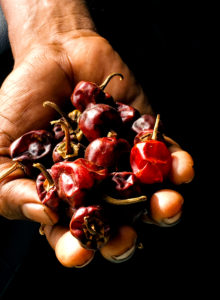
Last year on a trip to Chettinad,as we got closer to the antique street, we spotted sacks full of what they called the Chettinad gundu molagai. Before we could even get out of the vehicle we had someone thrust a palm full of these dried red chillies over the open window .The contrast in colour and texture was so vivid that I had to whip out my phone and take a picture of the round wrinkled beauties.These grow very close to Chettinad in the Ramnad district and are also known as the ‘Ramnad Mundu’.
I never thought I would lug back home many kilos of dried red chillies but somewhere we imbibe the traits of our elders and to feign surprise is pointless. It has been almost 9 months since these chillies have found a home in my store room and it is a source of much joy in my daily cooking .
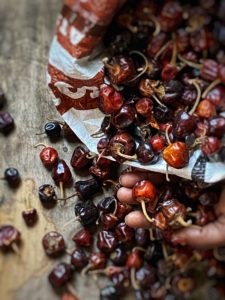
Don’t believe me ? It’s true. I honestly love using this variety when cooking traditional South Indian fare. It adds such visual appeal when blistered in hot oil, stem intact ,to sit pretty on top of that mound of chutney. Like a savoury cherry topping !
The monsoons, post summer is when the farmers around here like to plant the chilli saplings. In adherence to that ,we decided to plant some of the seeds from these fat chillies. At the first showers in end May we got overly exuberant ,went ahead and planted it and then wondered if it would survive. It did and we got our first harvest a few days ago, plump, green and not as wrinkled.
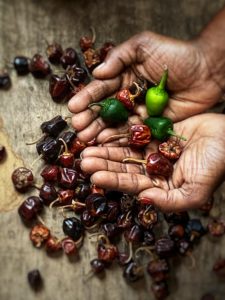
Having done a lot more research on the byadagi red chillies I realised that I knew little of this variety. It was so interesting to see the subtle differences between the ‘Ramnad mundu’ , the ‘Boriya mirch’ and the ‘Salem gundu’. The physical features of the three varieties are more or less similar with the rounded contours and paper thin skin. The Salem gundu is more of a brick red colour while the Boriya mirch and the Ramnad mundu are of many earthy tones from a light rust to a deep blackish burgundy. The Boriya chillies are apparently larger than the Ramnad gundu mozhagai and also not as fiery on the tongue.
It was also sad to learn that the gundu mozhagai farmers of Ramnad district have yet to earn a GI tag for this special variety. Apparently the officials at TNAU are doing their best for it to go through .Let’s hope it happens sooner than later. The name gundu is of course synonymous because of the fat ,rotund form of these chillies. “Ramnad Mundu” is the more widely used term. The inner socket of these dried chillies contain more than a teaspoon of seeds each. That’s a lot especially when compared to the small cavity it comes from. The seeds rattle against the papery skin when given a shake.
Today the kara chutney has many additions like tomato ,garlic etc. The original kara chutney of Chettinad, I’m told, consists of channa dal, small onions,Ramnad gundu mozhagai, tamarind , salt and other spices like cumin and coriander. It is a perfect condiment to eat with a hot tiffin dish during these rainy evenings.
I find it greatly amusing now when I think back to buying such a large sack of these chillies to bring back home, almost as if I had to hoard for winter. These chillies have been prominently featured on so many of my recent recipe posts and images,through this lockdown . Now that the seeds have germinated well and started fruiting, I plan to share these with whoever is interested in growing this wonderful variety,either in their farms or kitchen gardens.
But before that I do have one important task on hand; to make a jar of the Chettinad kara chutney for the person who inspired me to appreciate the true worth of this native ingredient !

Chilli Facts
1.The heat of a chilli is measured in Scoville Heat Units or SHU ranges from 0 SHU to approximately 1000,000 SHU.
The Ramnad Mundu measures at 0.166% ,with the capsicum being at 0.
2.The compound capsaicin fires up nerve endings causing the brain to release pain relieving endorphins.
- Chillies came into India in the 1500s and were brought in by the Portugese traders. Until then all our dishes were spiced only with black peppercorns.
Informative link on Indian chillies (Research credits goes mainly here )
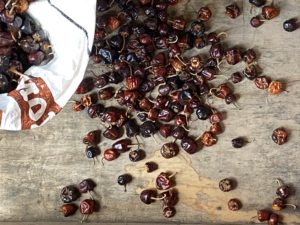
|
|

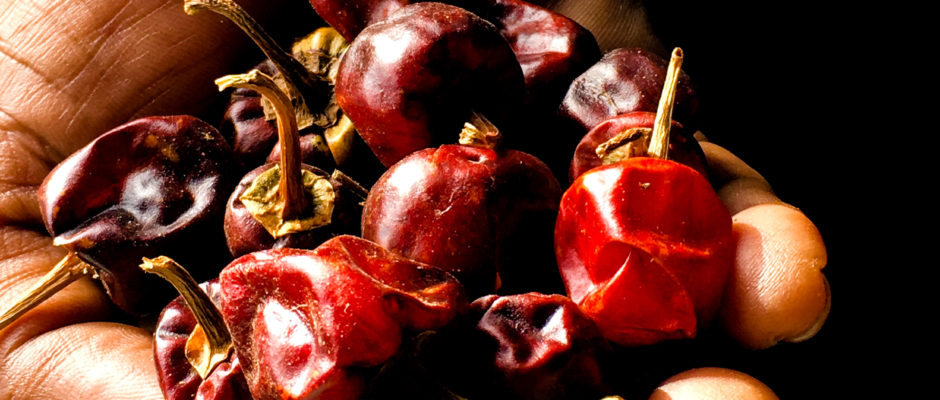
No comments yet.